This year marks the 10th live auction sale for First Arts, and by now, Ashley, Ingo, and I — along with our expert installers, Jose and now Miles — operate like a well-oiled machine. Last season, we finished our setup with a rare luxury: a few free hours in the afternoon. Proud of our efficiency and dog-tired from maneuvering pedestals and sculptures, Ingo and I indulged in one of my favourite recurring conversations, one we return to whenever there’s time.
We talked about our dream exhibitions.
It’s sort of like how people talk about what they’d do if they won the lottery – except for art nerds. We volleyed to each other, “what kind of show would you curate if you could borrow anything from anywhere [1]?" We imagined pairing Romanesque works from the Cluny with Salluit carvings. We entertained the idea of curating a definitive Karoo Ashevak retrospective, complete with a catalogue raisonné.
As I prepared to start writing for this season’s catalogue, I was reminded of one of my own dream exhibitions, a project I’ve been quietly assembling in my mind for some time. I even have a working title: Intuition & Imagination: The Parallel Vision of Luke Anguhadluq and Bill Traylor [2].
I touched on the idea briefly when writing about Fisherman + Hunter (Fisherman and Hunter) — a passing reference rather than a deep dive, out of respect for Colleen, our graphic designer, and because the image itself is more than strong enough to stand on its own. But for those interested, here’s my elevator pitch. If you’re a museum professional willing to give me carte blanche, I’m accepting inquiries. If you’re a Luke Anguhadluq or Bill Traylor enthusiast or scholar, I’m accepting coffee invitations, counterpoints, and collaborations — preferably in that order.
1. The fact that Ingo has curated exhibitions and published books makes these conversations feel less like idle speculation and more like something that could, theoretically, become reality. Then again, I imagine that’s exactly what people who play the lottery tell themselves.
2. I actually have several working titles, so, please, do not hold me to this if it ever does become a reality.
Art at the Margins of a Changing World
Bill Traylor (c. 1853-1949) and Luke Anguhadluq (1895-1982) come from vastly different cultural and geographic contexts. Traylor from the violently oppressive and racially stratified American South. Anguhadluq from the expansive Canadian North, where government-led relocations — whether necessary, disruptive, or both — undeniably reshaped a generation’s way of life and extended the reach of southern influence and governance.
Both men lived outside the structures of formal education, their understanding of the world shaped instead by lived experience, oral tradition, and a deep familiarity with their respective environments. And both men, late in life, turned to art; at once a means of economic survival and an act of remembrance. Their work became a way of preserving the worlds they had known, capturing not only personal memory but also the broader transformations unfolding around them.
For Traylor, change came through violent upheaval. Born into slavery on an Alabama plantation, he was denied the most basic freedoms, and even after Emancipation, his life remained constrained. Sharecropping kept him tethered to the land, bound to an exploitative system designed to maintain Black economic dependence. As Reconstruction crumbled, segregation and disenfranchisement systematically erased Black autonomy. By the time he began drawing in Montgomery, unhoused and overlooked, he was recording not just what he had seen but what had been taken away.
Anguhadluq came of age in a world structured by tradition but increasingly altered by external intervention. Raised in the Back River region of what is now Nunavut, he lived a nomadic life, moving with the seasons, following the migrations of animals and learning through practice and oral tradition. But, by the mid-20th century, the push toward permanent settlements was reshaping Inuit life. Government-led relocation efforts introduced new economic structures and shifted authority away from traditional knowledge. Though these changes did not carry the same brutality as the system that shaped Traylor’s life, they were insistent and nonetheless redefined Anguhadluq’s world.
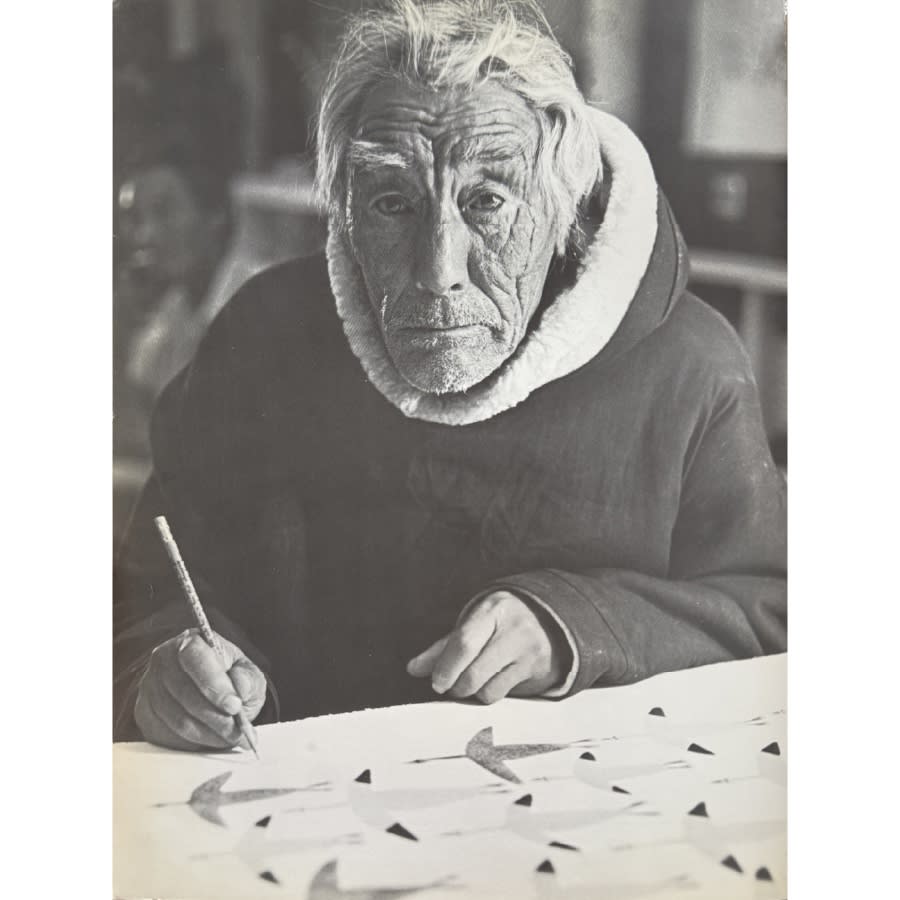 |
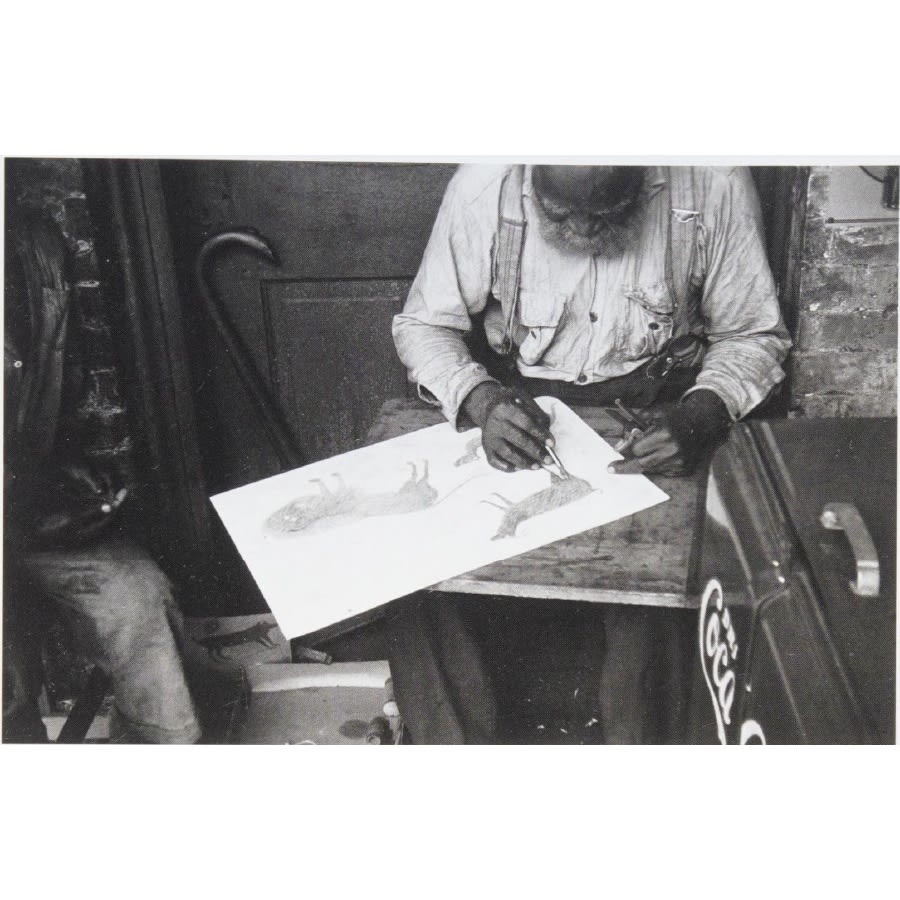 |
|||||
| Left: Uncredited Photo, reproduced in Cynthia Waye Cooks, From the Centre, (Toronto: Art Gallery of Ontario, 1993), frontispiece, as “Anguhadluq signing his 1973 print Geese in September.” | Right: Photo by Charles Shannon, “Bill Traylor’s Hands | Drawing Board and Cane, c. 1939, reproduced in Bill Traylor, 1854-1949 : Deep Blues, exh. cat., Robert Hull Fleming Museum, University of Vermont, June 17-Aug. 22, 1999. |
Art as Expression and Survival
For both men, art was neither a formally learned skill nor a profession in the conventional sense. Rather, Traylor and Anguhadluq turned to art out of economic necessity, and though their drawings emerged from vastly different traditions, they share a fundamental purpose: to preserve memory and bear witness to a world in transition; one where history is not written in books, but remembered, retold, and, finally, recorded in lines and forms.
Traylor, who had no formal training and no access to the art world, created art out of financial need. His drawings, made on scraps of discarded cardboard, were acts of self-preservation, a way of asserting presence in a world that had sought to erase him. His figures, drawn with a bold economy of line, embody not just Black American survival but the tensions and stories that shaped his experience.
Anguhadluq’s work reflects a quieter but no less transformative shift. Though he would not move to Qamani’tuaq (Baker Lake) until he was in his 70s, colonial influence had already begun to creep into his world well before the government imposed settlement efforts. Trade introduced firearms that shifted hunting from communal, ritualized efforts to individual pursuits. Religious missions, once distant, extended their reach through travelling clergy, and by the time Anguhadluq was a young man, many in his community had been baptized during trading expeditions. These gradual changes accumulated, reshaping the economic and spiritual foundations of his world long before he settled in then Baker Lake [3]. There, as an elder, Anguhadluq took up drawing. By the time he and other Utkuhiksalingmiut arrived, the financial landscape had already been reshaped by southern governance, with those more connected to the settlement and European culture occupying stable wage-earning positions [4]. Traditional hunting economies, once central to Inuit life, had eroded under environmental hardship, government relocation, and the imposition of a cash economy.
With few viable alternatives, many turned to the arts programs established under Southern, white administrators, which provided one of the only accessible pathways to self-sufficiency. For Anguhadluq, drawing was both a necessary adaptation for economic survival and an unexpected means of expression. Encouraged by administrators (again, white and Southern) to depict the traditional scenes he knew, he found himself recording a way of life that those same forces had been working to dismantle.
Like Bill Traylor, Anguhadluq’s creative practice was shaped by economic displacement, emerging in response to a world that had been fundamentally altered by forces beyond his control. Neither artist sought to depict an idealized vision of place; instead, they filled their compositions with the figures, animals, and gestures that defined their lived experiences. Their works, then, function as acts of veneration. An assertion of the people, creatures, and ways of being that persisted, even as the world around them continued to shift.
3. I am indebted to Cynthia Waye Cooks’s From the Centre (Toronto: Art Gallery of Ontario, 1993), pp. 1-15 for this information. Cook’s extensive research and clear, engaging writing make this essential reading for anyone interested in the work of Luke Anguhadluq.
4. See Marion E. Jackson, Baker Lake Inuit Drawings: A Study in the Evolution of Artistic Self-Consciousness, University of Michigan, PhD Dissertation, 1985, p. 75
I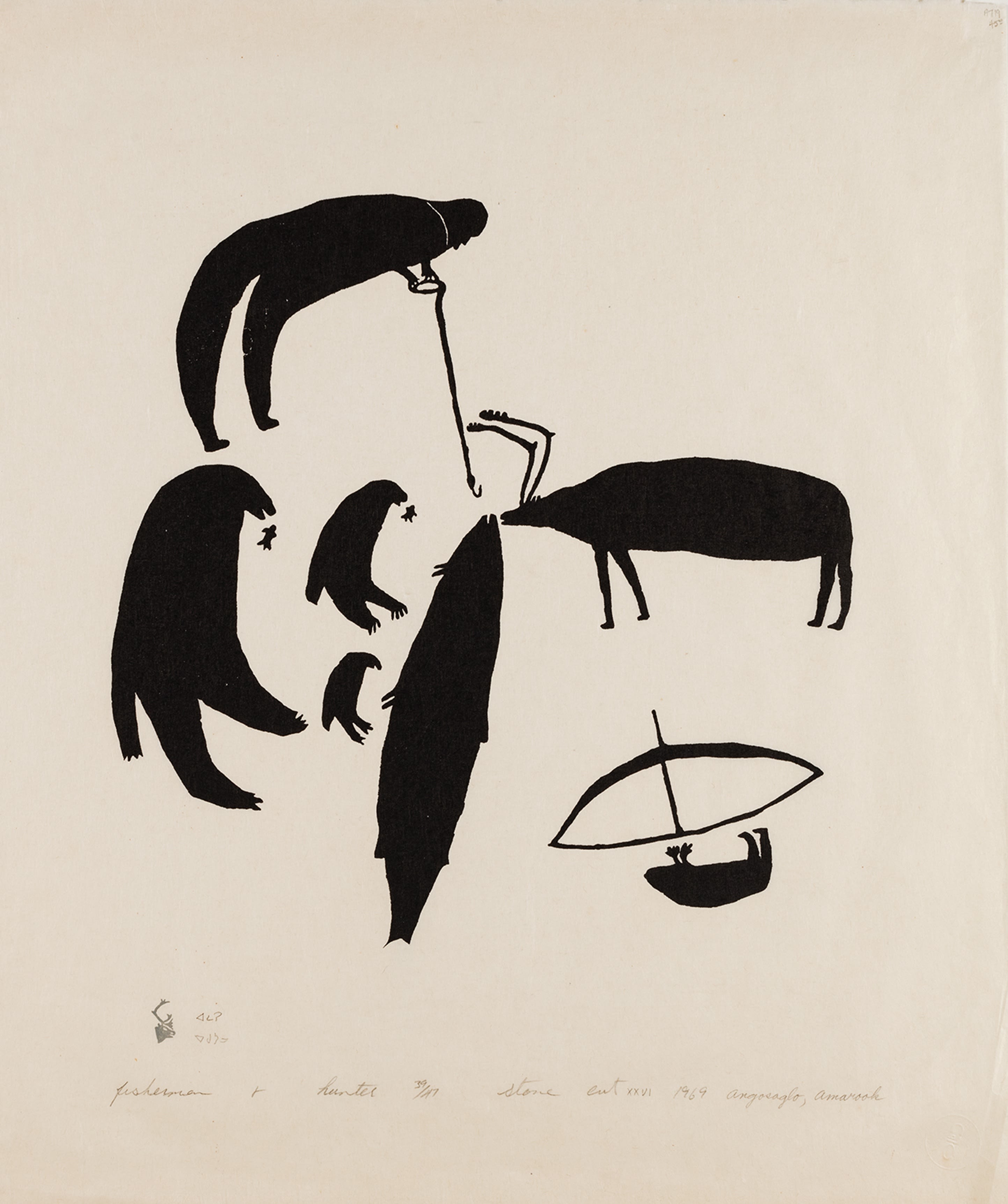 |
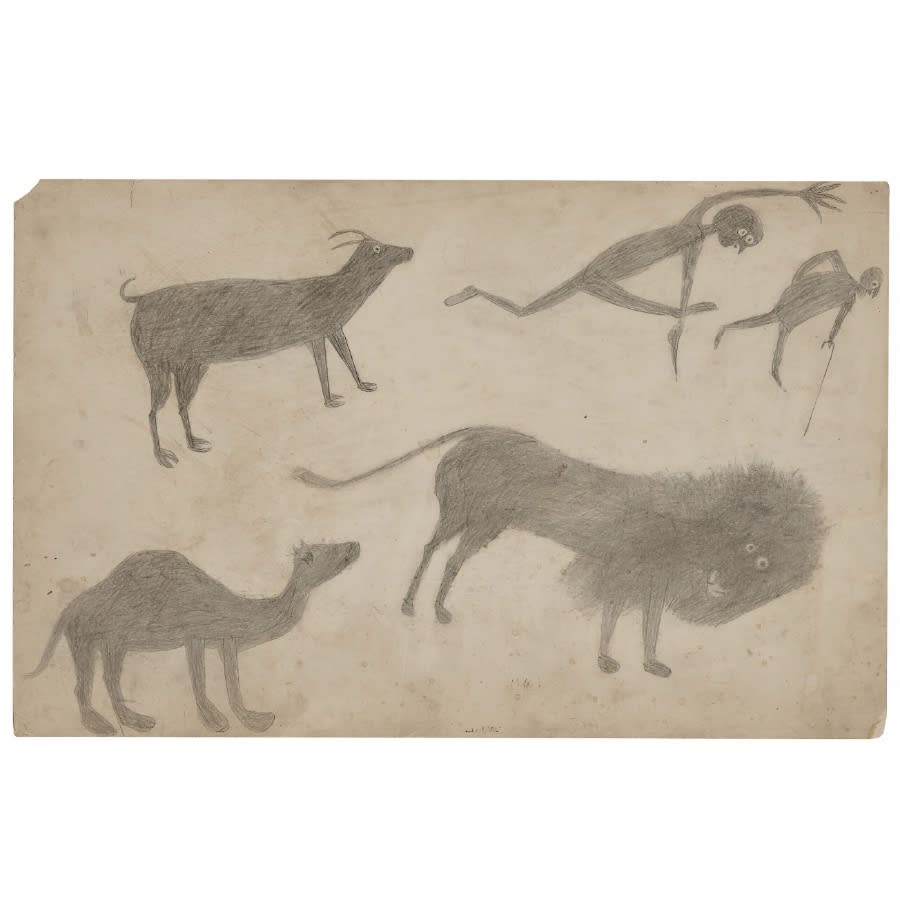 |
|||||
|
Left: Luke Anguhadluq, Fisherman + Hunter (Fisherman and Hunter), 1969 (1970 #24), stonecut, 24.25 x 22 in (61.6 x 55.9 cm), framed, 39/47
|
Right: Bill Traylor, Goat, Camel, Lion and Figures, c. 1939 graphite on repurposed card, 14 x 22 in.) which sold at Christie’s on 18 Jan 2023 for US$ 252,000, https://www.christies.com/en/lot/lot-6410384, accessed 25 March 2025. |
Distilled Storytelling Through Form
Both Traylor and Anguhadluq created compositions brimming with movement. Their figures are fluid and dynamic, capturing not just scenes of life but the feeling of it.
For each, art was intuitive, untethered to academic tradition, and built instead on memory, observation, and experience. The resultant works from both men operating with a similar modus operandi (or lack thereof) – surprisingly and despite hundreds of miles and different cultural contexts – share a striking stylistic kinship.
Both Anguhadluq and Traylor developed a bold, distilled visual language, reducing figures to their most essential forms while infusing them with an undeniable vitality. Their subjects are often poised mid-movement, bodies tensed in exertion, caught in moments of struggle or transition, as if the world they inhabited was still in motion beyond the edges of the page.
For each, the figures on the page exist with a dreamlike quality that blurs memory and imagination. They distilled down to their essence and often without any extraneous details like a landscape or even a sense of up and down with which the view can orient themselves. Both created works without concession to Academic rules or even conventions of proportion, perspective, or compositional hierarchy. Instead, their figures exist on their own terms: immediate and uncompromising.
Parallel Subjects and Structures
Animals
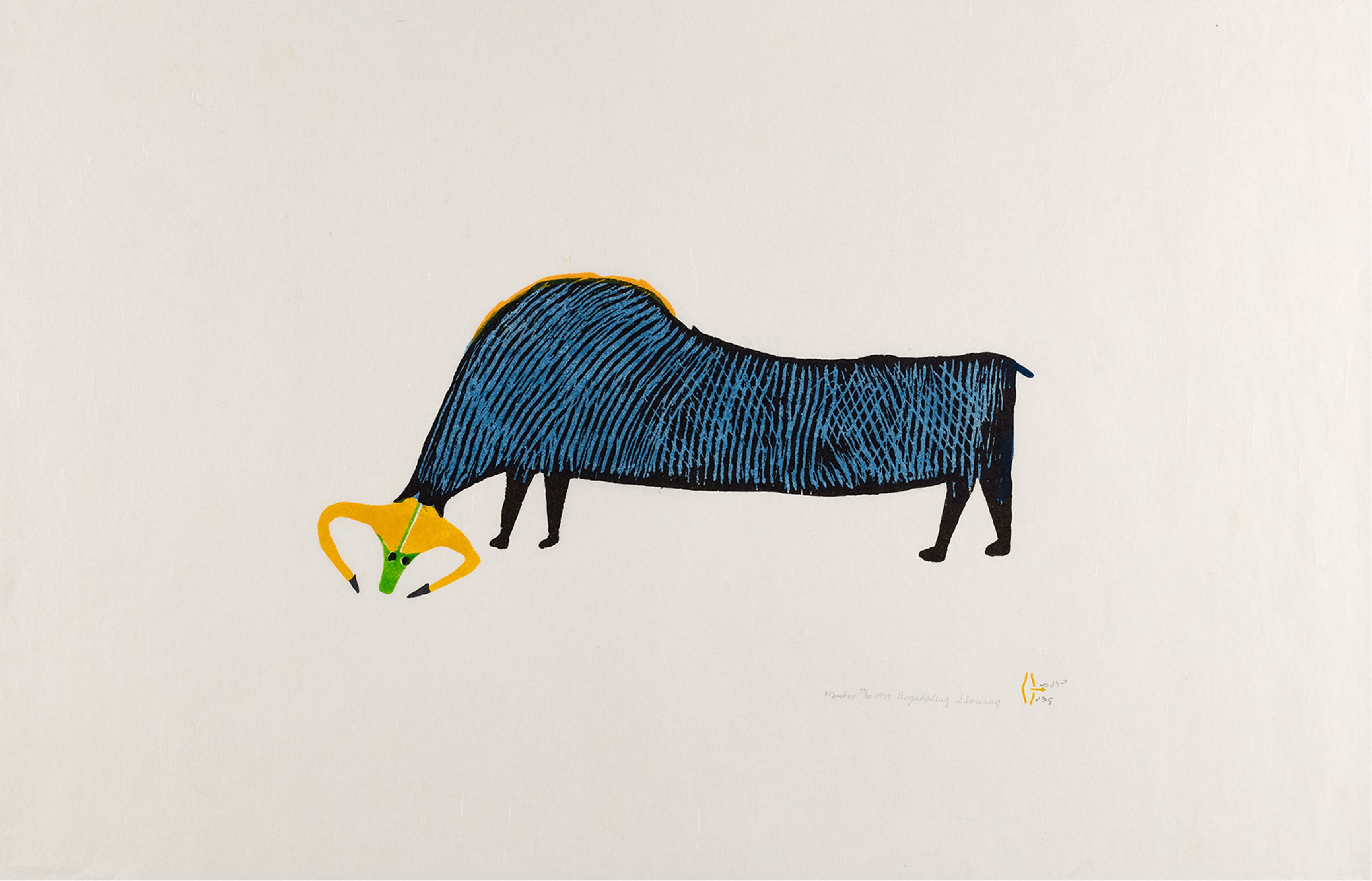 |
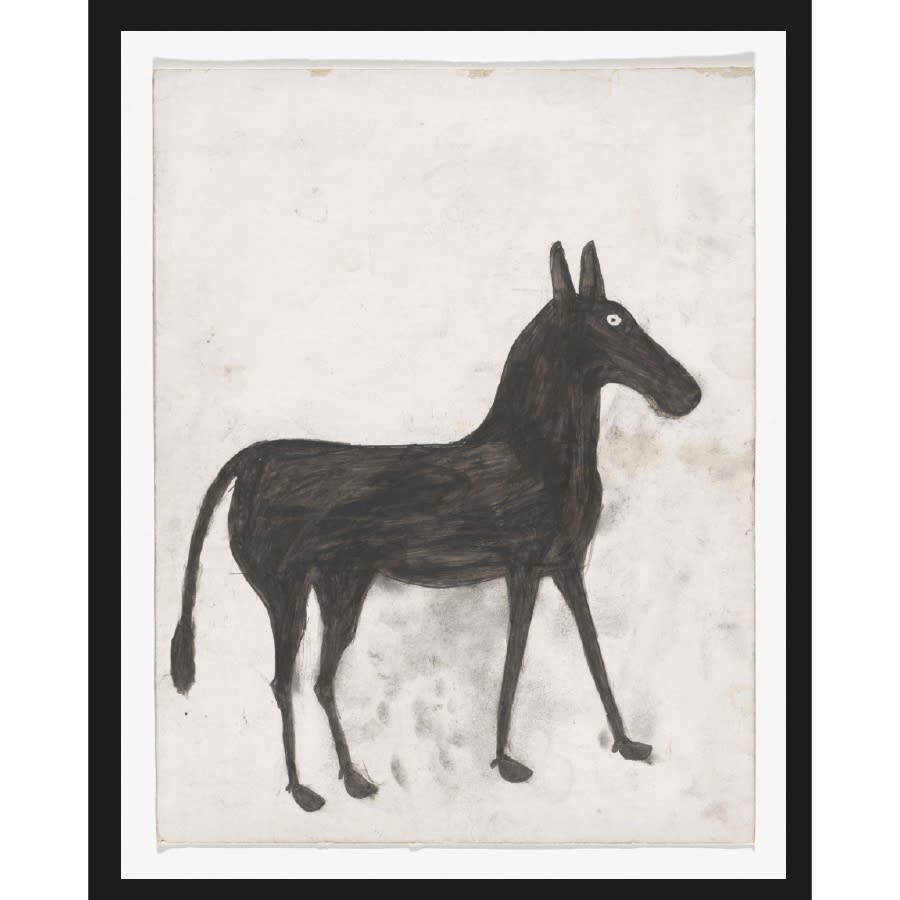 |
|||||
|
Left: Luke Anguhadluq, Muskox, 1977 #4, stonecut and stencil, 21.5 x 31.5 in (54.6 x 80 cm), 14/50 Upcoming 9 June 2025 Auction, Lot 15, Est. 2,500 — 3,500
|
Right: Bill Traylor, Untitled (Black Horse). c. 1939-42, gouache on board, 14 x 11" (36 x 28 cm), Museum of Modern Art, New York, NY, Gift of Thea Westreich and Ethan Wagner, object no.31.1999 |
Both Luke Anguhadluq’s Muskox and Bill Traylor’s Untitled (Black Horse), pictured above, exhibit a strikingly similar compositional sensibility. Each artist isolates a single, strong, and solid animal, positioning it centrally and surrounding it with negative space that heightens its visual impact. Their shared aesthetic of restraint, eschewing environmental detail in favour of bold form, reflects a compositional instinct that prioritizes presence over narrative, distilling their subjects to their most fundamental and enduring essence.
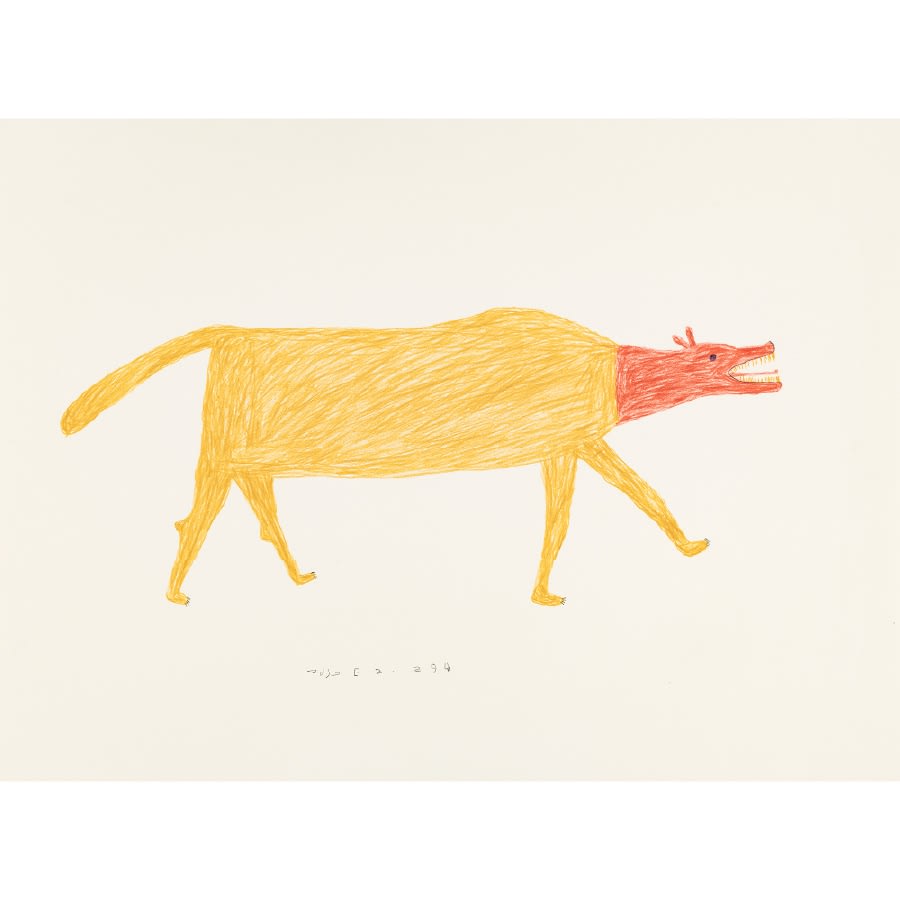 |
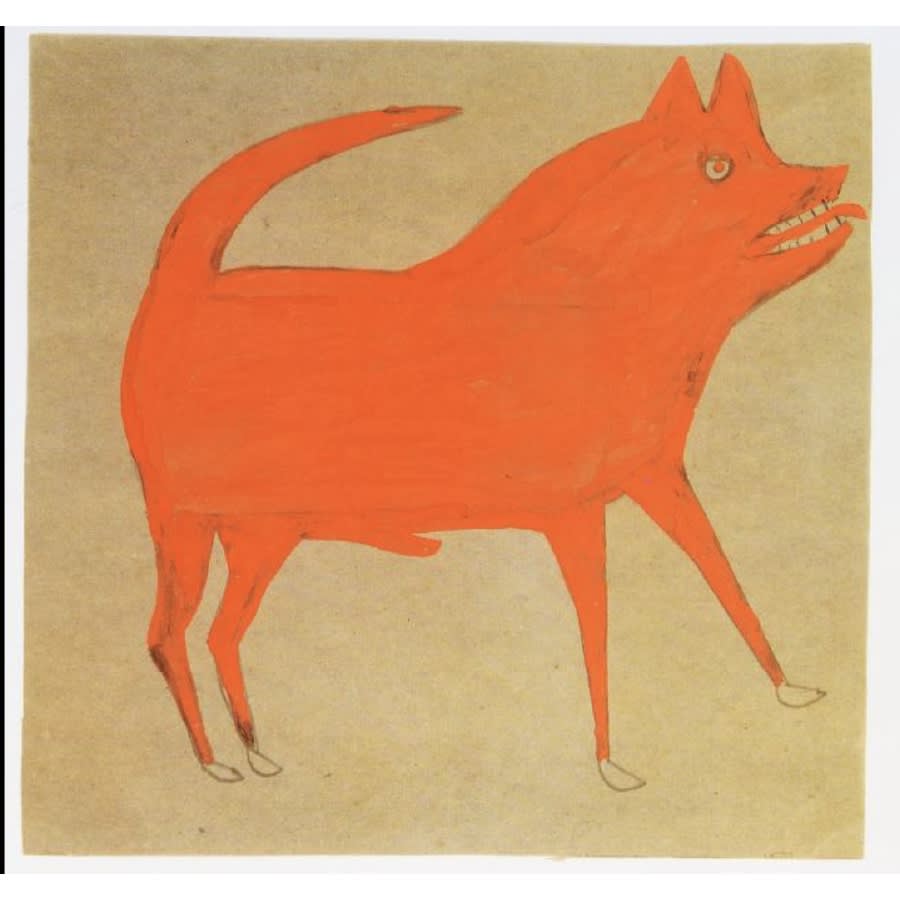 |
|||||
|
Left: Luke Anguhadluquke Anguhadluq, Panting Wolf, c. 1975, pencil crayon on paper, 22.5 x 30 in (57.1 x 76.2 cm), Sold First Arts, 3 Dec 2020, Lot 131. |
Right: Bill Traylor, Red Dog, 1940/1942, poster paint and pencil on cardboard, 29.2 x 24.1 cm, reproduced in Bill Traylor, 1854-1949 : Deep Blues, 1999 (op. cit.), cat. no. 21, as “William Louis-Drefyus Collection.” |
Women
Women occupy a central role in the works of both Bill Traylor and Luke Anguhadluq, often emerging as dominant figures within their compositions. Yet these are not the grand portraiture of salons, nor do they conform to the stylized femininity of dominant artistic traditions. Instead, both artists root their depictions of women in lived experience, portraying them not as passive subjects but as active participants in daily life.
For both Traylor and Anguhadluq, women are seldom rendered as still or ornamental. In Traylor’s compositions, women walk, gesture, and even fight, their bodies poised mid-motion, defined by expressive postures. Anguhadluq’s women are often shown at work within the rhythms of communal life: skinning fish at camp, fashioning summer tents, or journeying with walking sticks on long migrations [5].
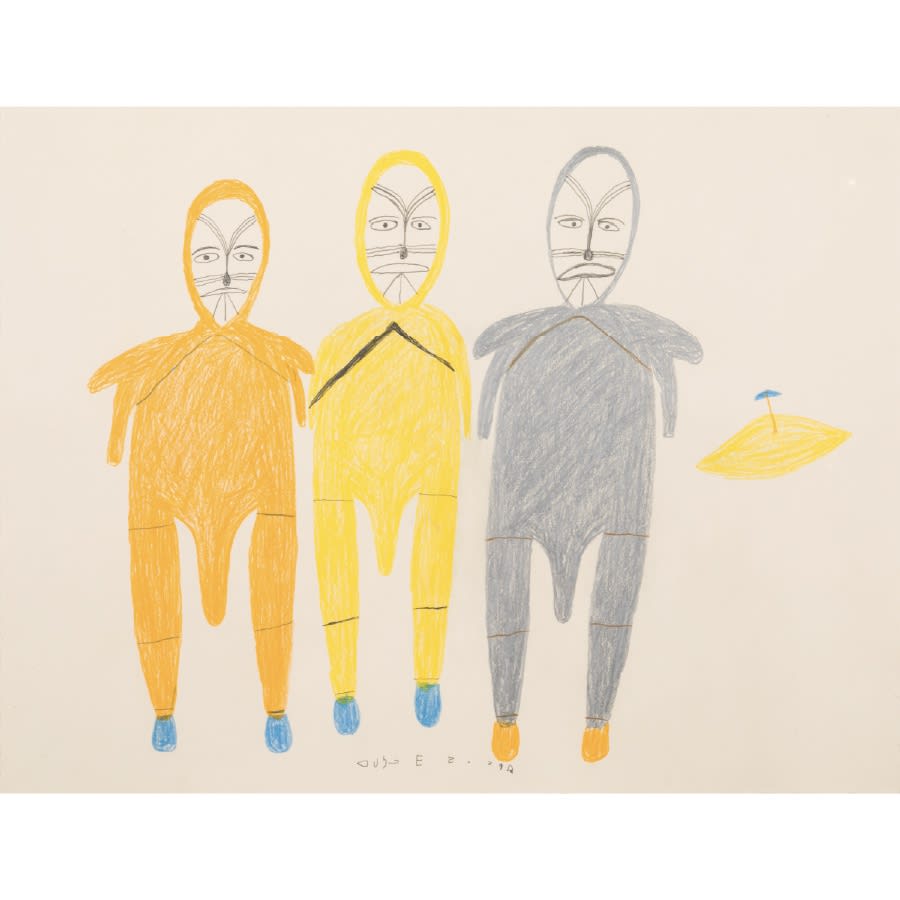 |
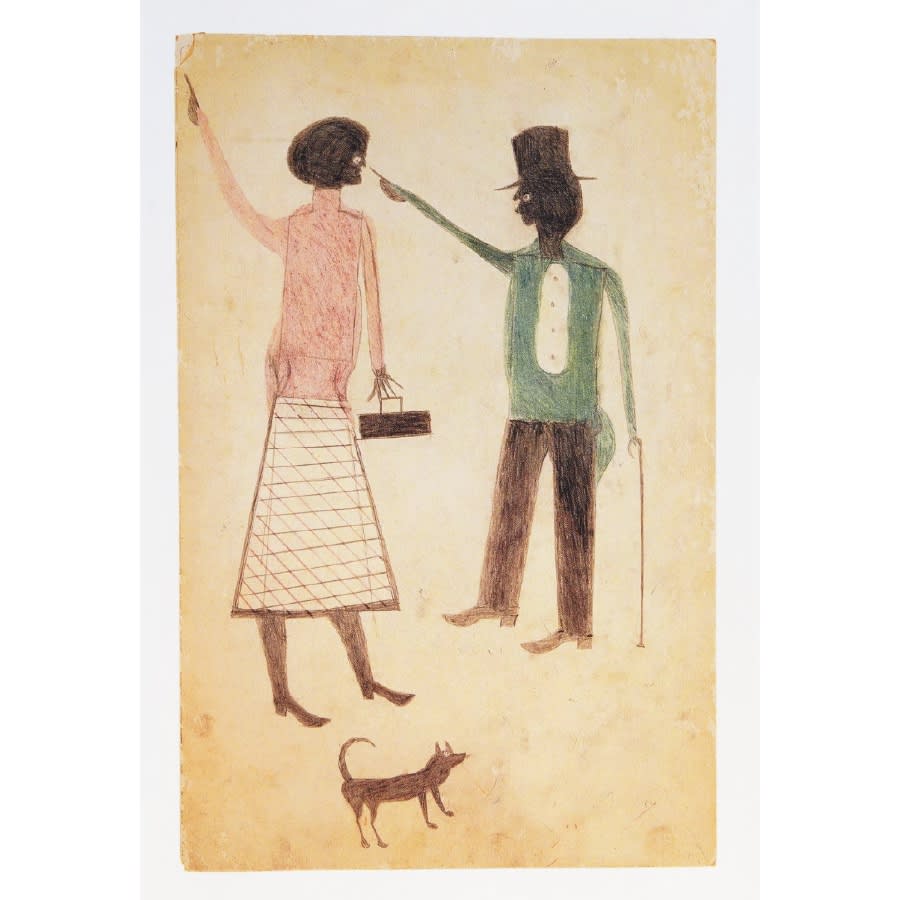 |
|||||
|
Left: Luke Anguhadluq, Composition with Three Women and an Ulu, c. mid 1970s, coloured pencil and graphite on paper, 20 x 26 in (50.8 x 66 cm), framed, |
Right: Bill Traylor, Man and Woman Pointing with Dog, coloured pencil and pencil on cardboard, reproduced in Bill Traylor, 1854-1949 : Deep Blues, 1999 (op. cit.), cat. no. 7, as “William Louis-Drefyus Collection.” |
Traylor, likewise, demonstrates a keen awareness of the visual markers of femininity. His women are distinguished by the patterns on their simple skirts or dresses, small but intentional notes of embellishment within his otherwise stark compositions. Purses, too, are often included, suggesting a similar impulse to highlight objects associated with women’s social and personal identity.
Spirituality
Both Anguhadluq and Bill Traylor engaged in expressions of spirituality as it related to their respective lived experiences [6]. Again, however, in the case of both men, spiritual engagement is inseparable from physical presence, from the energy of bodies in motion, and the rituals that define communal life, rather than a purely religious doctrine.
Interestingly, again there is a kinship for both men compositionally. Both artists frequently structure their compositions around circular formation that signify a sacred space [7].
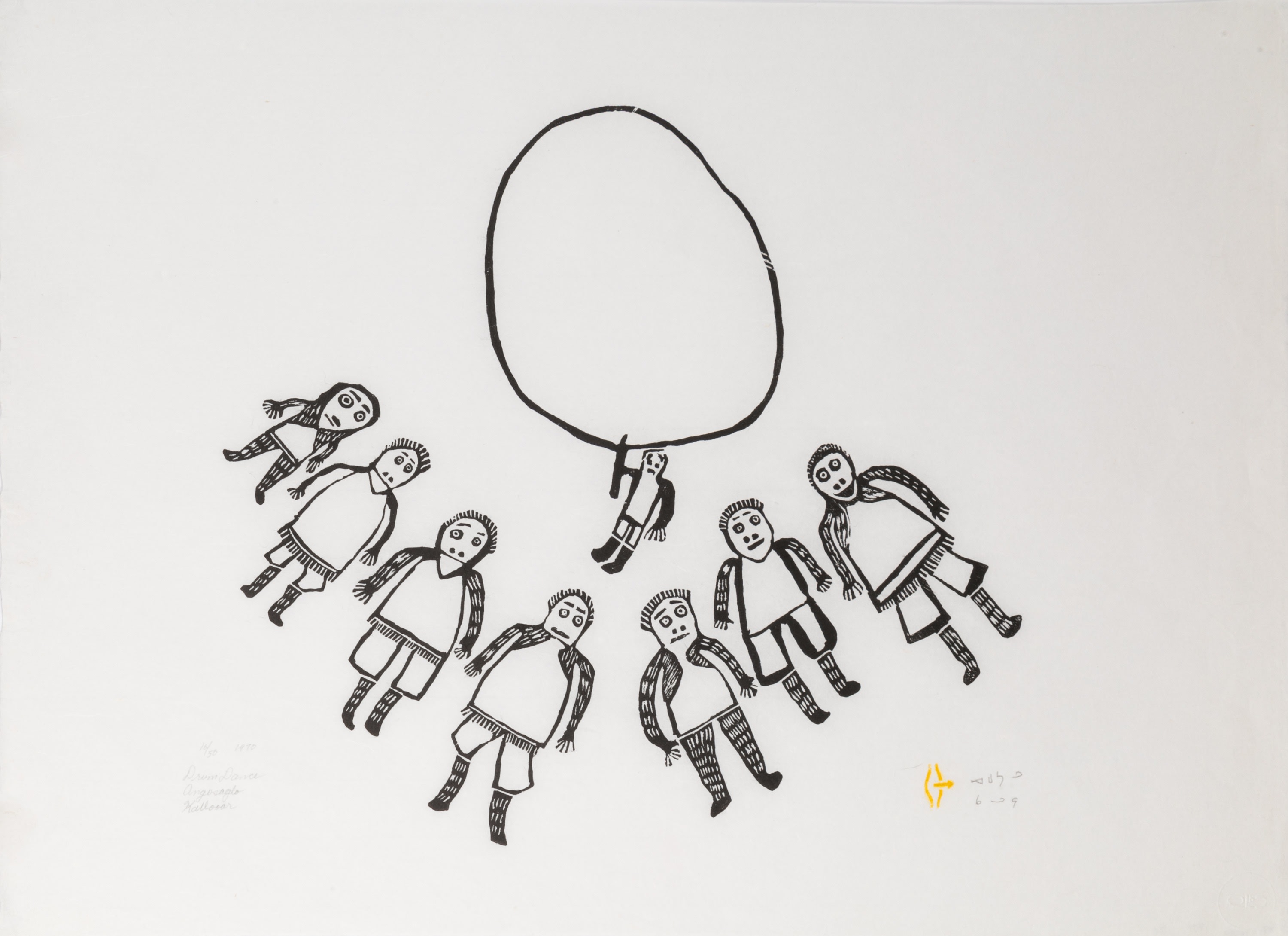 |
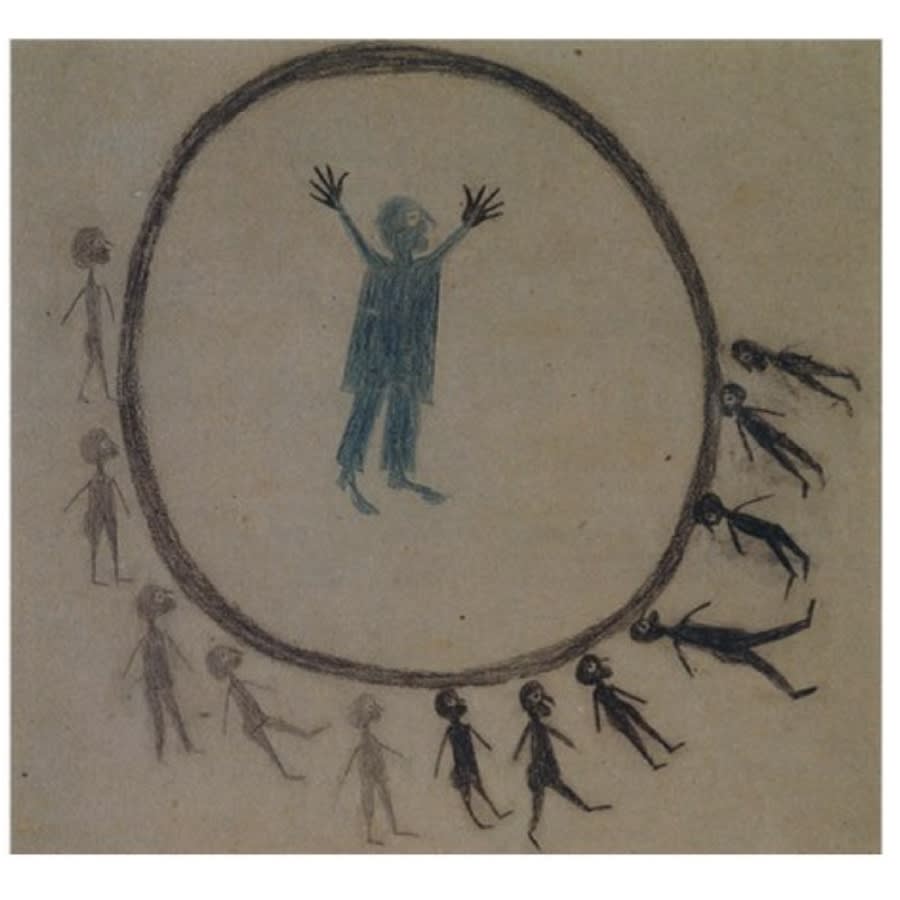 |
|||||
|
Left: Luke Anguhadluq,
Drum Dance, 1970 (1971 #27)
stonecut, 18.5 x 24.5 in (47 x 62.2 cm)
16/50
Available at First Arts, POA |
Right: Bill Traylor, Preacher and Congregation, c. 1939-42, Collection of Gael Mendelsohn. Reproduced on https://www.hopewellproject.net/. Accessed 19 March 2025. |
For Traylor, the preacher often appears as a central figure, fervently gesturing within a literal drawn circle and / or surrounded by smaller, rhythmically arranged figures forming a circular composition. These images evoke the ring shout, a spiritual practice in which participants moved counterclockwise, clapping and singing in call-and-response. A defining tradition of Black religious life in the American South, the ring shout may reflect the clandestine outdoor services held by enslaved people before emancipation. Spaces of worship that operated outside the bounds of white-controlled Christianity. It was both an expression of faith and an act of resistance.
Anguhadluq’s drum dance scenes, likewise, use the circle as a structuring device. Similarly, it is one that transcends mere formal arrangement and instead speaks to ritual, rhythm, and energy. In Drum Dance, the drum itself is central and provides the gravitational force around which figures are arranged, their bodies tilted forward, caught in motion, absorbed in the experience of sound. And, like Traylor’s works, which may recall the clandestine worship practices of enslaved Black Americans, Anguhadluq’s continuous depiction of drum dances may serve as an assertion of something once threatened — an artistic veneration of a practice that had been discouraged, if not entirely suppressed, by the encroaching structures of missionary influence. These works do not simply document the past; they insist on its presence.
5. See Cook, 1999, cats. no, 48, 57, and 60.
6. Interestingly, in my research, I found no explicit documentation that either Bill Traylor or Luke Anguhadluq were actively engaged in the Christian religion while creating their artworks. Traylor was born into slavery on the plantation of John Getson Traylor, a prominent Baptist in the Alabama Association, and it is likely that he was raised in the church. However, it was not until 1944, at the age of 91, that he was baptized into the Catholic faith at St. Jude Church in Montgomery. Likewise, I could find no direct reference to Anguhadluq being baptized, but William Eakin and Jack Butler, in their photo essay Baker Lake 1983-84, published in Arts Manitoba (Fall 1984, p. 20) and cited in Cook, 1999, p. 13, footnote 43, suggest he had a complex relationship with Christianity. Upon his death in 1982, Anguhadluq specifically requested not to be buried in the Anglican cemetery. Instead, his body was transported by dogsled to a hill overlooking Baker Lake—a place where he had spent significant time observing caribou.
7. The use of the circle as a sacred space is not a new concept in art but it is particularly striking that both Traylor and Anguhadluq rely on it so consistently when depicting moments of spiritual practice.
Closing Thoughts from the Department of Imagined Exhibitions
So there it is, folks. The shape of an idea, anyway.
Whether it ever leaves the realm of lottery-like daydreams remains to be seen. But I hold onto the hope that one day, these two artists might share a room — publicly or privately — where their stories and visions, united by an instinctive approach to form and memory, could be seen not just side by side, but in conversation. Two distinct lives. Two singular visions. Each illuminating the other.
